15 watt energy saving lamp corresponds. Comparison of LED lamps, fluorescent lamps and incandescent lamps
Rising electricity prices force people to save in areas where they had not even thought about expenses before. For example, the replacement of incandescent lamps has become widespread. There are much more economical light sources - fluorescent and LED. But how to decide which ones to install - energy-saving or LED lamps? To make a decision, you need to compare their characteristics. And it's better to do it objectively.
Which ones are more economical?
The name “energy saving” has taken root in our country in relation to compact fluorescent lamps (CFLs). At the time of their widespread use, they were the most economical. Especially if you compare them with conventional incandescent lamps, housekeepers consume 3-4 times less energy. Later they began to “promote” LED light sources. They consume even less electricity, which means they are the most economical.
To see the difference, look at the table. It shows the power consumption of LEDs, fluorescent lamps and those familiar to us with tungsten filament. They all have the same (or almost) lumen output, but as you can see, the power consumption is very different. A 3 W LED lamp is equal in light power to a 7 W energy saving lamp or a 20 W incandescent lamp. LED lamp by 5 W will replace a 12-13 watt “economy” or 40 watt incandescent. These are averaged data, since different manufacturers the indicators change somewhat, but, in general, the proportions remain the same.
| Incandescent lamps | Luminescent and energy saving | LED | Light flow |
|---|---|---|---|
| 20 W | 5-7 W | 2-3 W | 250 lm |
| 40 W | 10-13 W | 4-5 W | 400 lm |
| 60 W | 15-16 W | 6-10 W | 700 lm |
| 75 W | 18-20 W | 10-12 W | 900 lm |
| 100 W | 25-30 W | 12-15 W | 1200 lm |
| 150 W | 40-50 W | 18-20 W | 1800 lm |
| 200 W | 60-80 W | 25-30W | 2500 lm |
Just from this table alone it is easy to say that energy-saving or LED lamps are the most economical. But this is not all the advantages of LED technology. Let's talk about them further (as well as about the shortcomings, however).
Life time
If we talk about service life, the average for energy-saving ones is 10,000 hours. For LEDs this figure is higher: on average - 30,000 hours, but there are requests from manufacturers for 50-60 thousand hours of operation.
It seems that LED lamps are the leaders here, but there is one nuance. Both technologies have quite significant drawback: Over time, their glow intensity gradually decreases. The so-called “burnout” occurs. In this regard, it is worth focusing not on the stated operating time, but on the warranty period. It more accurately reflects the actual position. After all, if something happens to the lamp at this time, the manufacturer will have to replace the device with a new one. The less often such cases happen, the better. That is why manufacturers tend to underestimate the warranty period, since they bear financial responsibility.
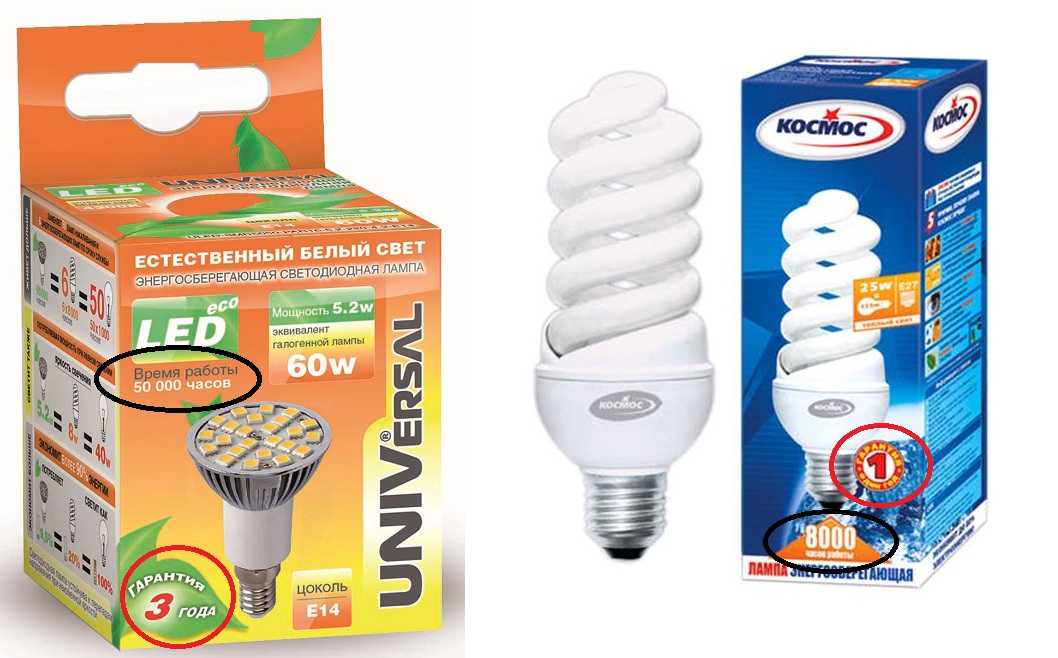
And if you compare energy-saving and LED lamps by warranty period, there is a difference too. For LED average- 3 years, for housekeepers - 1 year. There are more/less, but these are specific. So here, too, when comparing whether energy-saving or LED lamps are better, the best is LED technology.
Dimensions and appearance
Everyone knows the type and size of energy-saving lamps. This is a tube with a phosphor twisted into a complex spiral. The most compact ones can fit into a medium-sized lampshade, but in most cases they stick out from ordinary lamps, and with built-in ones they don’t look so great at all.
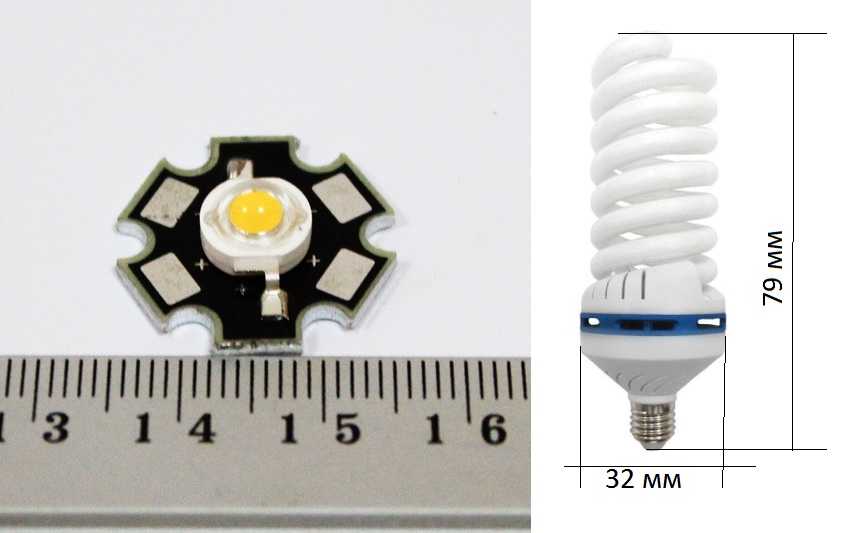
LED lamps can have very small sizes. A three-watt crystal can be made in the form of a circle with a diameter of 1.5-2 cm. And this is the equivalent of an energy-saving device of 7 W, which has a minimum size of 32 * 79 mm. Such miniature sizes of LEDs make it possible to make recessed lamps with a very small thickness - 2 cm or less. And this is with a radiator to remove the heat that the LEDs emit during operation. Such small sizes allow them to be built into furniture or to lower suspended and suspended ceilings to a very small height.
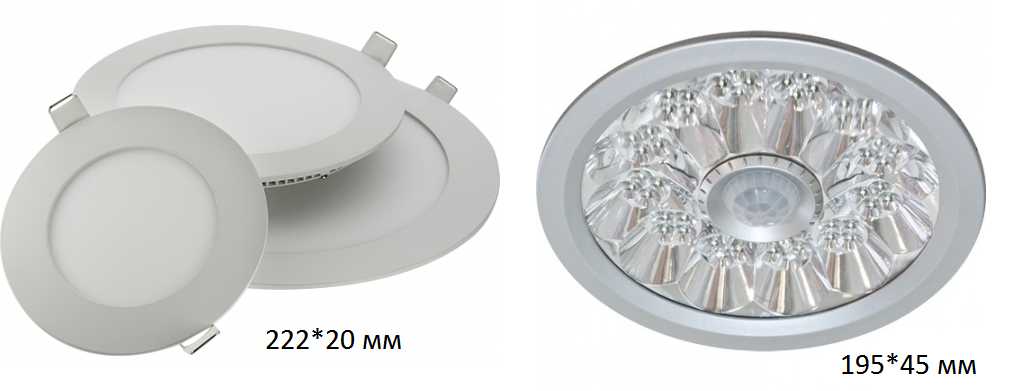
If we talk about the more familiar format - with a flask, then the shape and size of the flask can be completely different. This part is optional - the LED does not require a vacuum or a specific gas environment. So this is rather a tribute to tradition. There are bulbless lamps that are called “corn” for their characteristic appearance. Their service life is determined by the quality of the LEDs, and not by the integrity of the shell, which, in fact, does not exist. You can even assemble lighting altogether from individual LEDs on a metal radiator plate or even without it. In general, both the size and appearance of LED lamps may be different. And here, deciding whether energy-saving or LED lamps are better, we certainly come to the conclusion that LED lamps better - they can be almost invisible, they can have any shape and size.
Convenience and safety of use
Everyone knows that in fluorescent lamps the tubes are filled with phosphor, which begins to glow under certain conditions. It takes some time to create these conditions. Sometimes it is almost unnoticeable, and sometimes the delay after turning on can be a second or even a little more. This is not the most pleasant phenomenon to put up with. LED lamps light up immediately after voltage is applied. They are certainly better at this.
Today, more and more people are trying to make lighting with the ability to change the light intensity. This is achieved either by a complex circuit with a large number of switches, or - small device, which allows you to smoothly change the level of glow. But the fact is that not all lamps can work with a dimmer. Energy savers cannot. They need a certain voltage level and its shape, and the dimmer distorts the shape. But some LED lamps can work with this device. Just look for dimmable ones when choosing LED bulbs. This ability is indicated in the technical specifications. The downside is that such light sources with equal characteristics are more expensive.
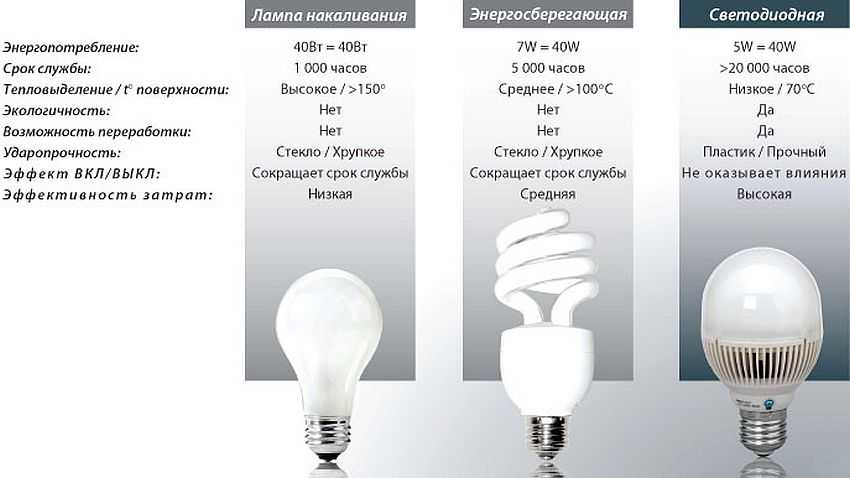
Another point in favor of LED lamps. Their flask (if they have one) is made of impact-resistant plastic. Energy-saving fluorescent lamps are made of glass. Moreover, damage to the tube is fatal - the light source stops working. In addition, some (cheap) housekeepers contain mercury vapor, so a damaged glass tube with phosphor can cause serious harm to health. This also leads to difficulties with disposal - special enterprises are needed to process such lighting fixtures.
And the last point regarding ease of use - it is impossible to restore either an incandescent lamp or a fluorescent lamp after failure. If damaged, they completely lose their functionality. LED lamps usually consist of a number of crystals located on the body. When one or more crystals fail, the luminous flux decreases, but light is still emitted, albeit in smaller quantities. In addition, if desired, you can replace the burnt out elements, restoring the previous brightness.
So, when deciding whether energy-saving or LED lamps are better in terms of ease of use, we see that LED lamps are more practical and safe.
Prices and yet what is better...
Everyone knows that LED lamps are more expensive. This is perhaps the only point where fluorescent lamps are ahead. But today the price difference is not as great as before. They are already almost equal. If we take, for example, light sources from the same manufacturer with the same equivalent (or almost the same) in relation to incandescent lamps, then the prices are almost identical.
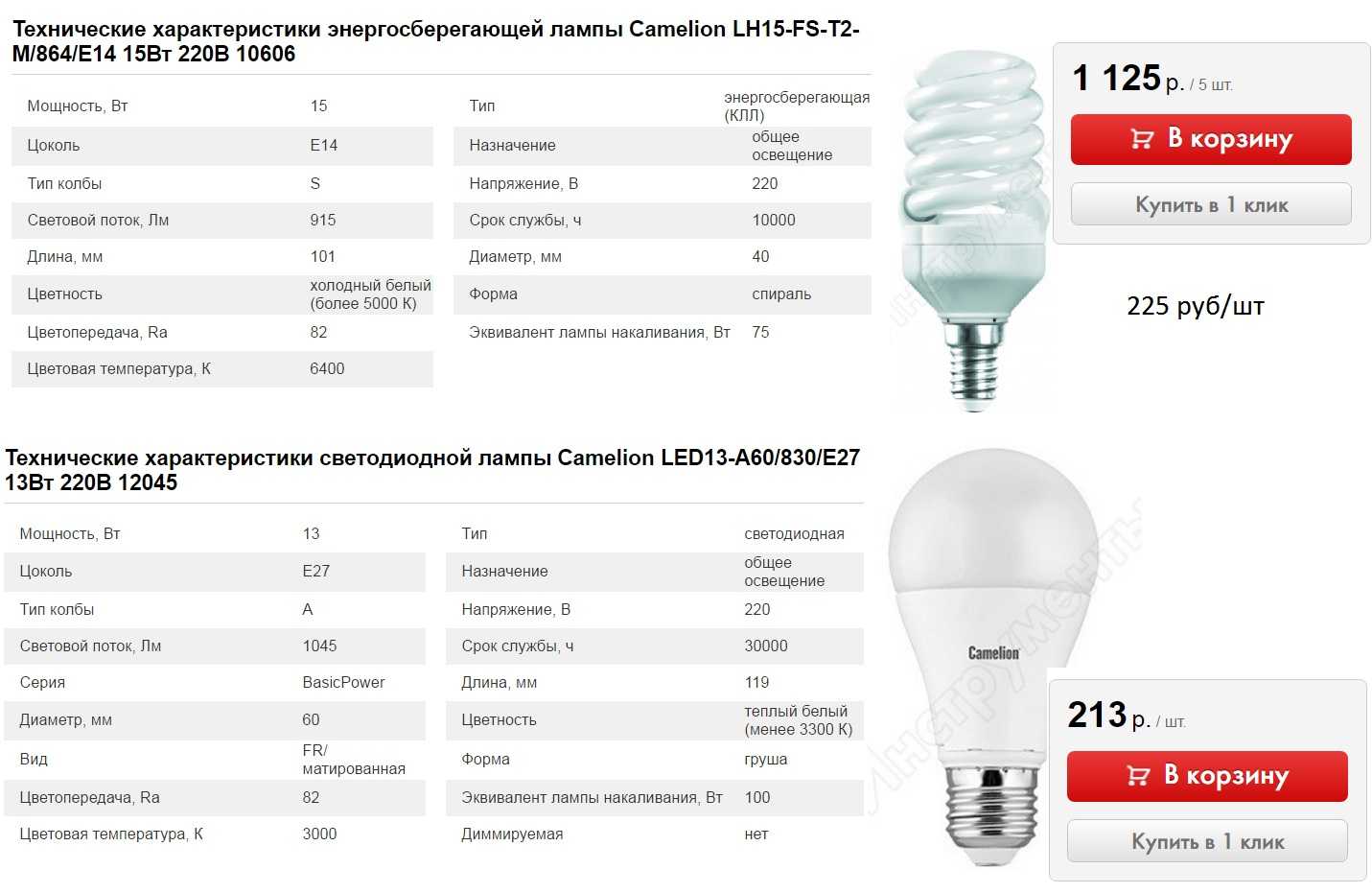
Here, even the LED price is lower. True, the color temperature is different...
For example, lamps from Camelion (Chamelion). Energy saving lamp - LH15-FS-T2-M/864/E14 is the equivalent of a 75 W incandescent lamp, costs 160-225 rubles. LED lamp - Camelion LED8-C35/830/E27 (also equivalent to 75 W incandescent) - 170-230 rubles. Both series are basic, without any special bells and whistles, and if you take into account the savings on electricity (8 W versus 15 W) and service life (10,000 hours and 30,000 hours) and all the other “goodies”, then even the question “which is better is energy-saving or LED lamps" does not occur. The solution is probably clear - LED lights are more economical, easy to use and durable. They are best installed instead of incandescent lamps.
But in the press and on the Internet there is a lot of Lately Information has appeared that LEDs are harmful - they emit a harmful spectrum and flicker. There is no confirmed data about the spectrum, but luminescent ones flicker, flicker. But they always flicker, and there are LEDs without ripples, they just cost much more. In general, the decision is yours.
The main task of any lighting device is to create lighting that corresponds to the required level. But, since the lamp consumes electricity, and it’s not cheap, then second important parameter when choosing it turns out to be power. While it comes to incandescent or halogen lamps, the ratio of power and intensity luminous flux were connected by simple correspondence.
But when it comes to energy-saving devices, it is necessary to take into account the peculiarities of their design.
Lamp arrangement
- The source of light in an incandescent lamp is a wire conductor. Under the influence of electric current, it heats up and begins to glow. The conductor is placed in a glass flask filled with inert gas and halogens. The design has a fuse that prevents destruction of the bulb when the filament breaks.
There are a great many types of devices and, despite the relatively low operating efficiency and fragility, they are unlikely to leave the market soon. The fact is that such a lamp is insensitive to voltage changes, which makes it very different from modern ones. perfect devices, sensitive to this indicator.
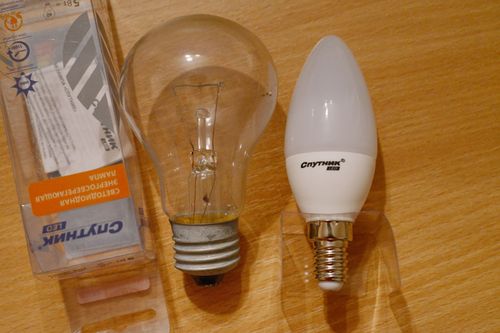
- LED lamps have a fundamentally different structure. Here, the filament body is a semiconductor that generates optical radiation when an electric current is passed through. The color of the light flux is red, blue, determined chemical composition LEDs. To get the usual white light, different LEDs are combined in the lamp and light filters are installed.
The luminous flux power far exceeds that of an incandescent lamp, as does its durability. However, this device also has its weak point - the ballasts. The fact is that for a semiconductor you need D.C., while the power grid supplies AC. And the higher the quality of the converters, the more dependent they are on the quality of the source current. The photo shows an LED lamp.
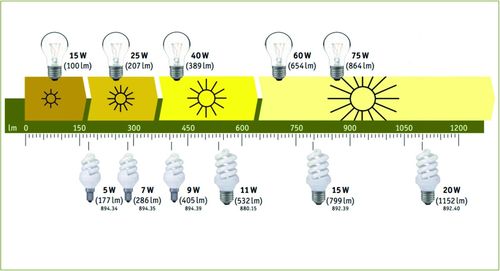
Basic Concepts
For conventional lighting devices, the power consumption is equivalent to the intensity of the luminous flux. But as soon as the lamps began to be improved, the direct relationship began to change. And now the main characteristic is the power of the luminous flux.
This value corresponds to the amount of light energy in the measured light flux. The unit of measurement is lumen. This characteristic indicates exactly what level of illumination will be when installing an LED lamp or any other lamp with the specified value.
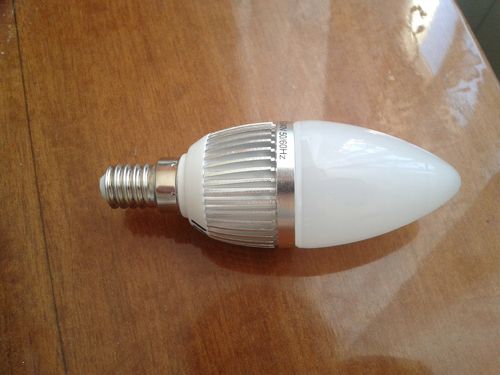
The correspondence between power consumption, that is, the amount of electric current that is necessary for the operation of the device, and the intensity of the luminous flux for different devices is different.
Value ratio
The correspondence between the power of LED lamps and energy-saving lamps to incandescent lamps is approximately considered to be 1:10, which is incorrect. Firstly, the bulb on such devices is matte, since the light in a powerful diode device is dazzling and resembles welding. This means that the intensity of the light flux that enters the room decreases by 20%. Secondly, approximately 1W is required to ensure the operation of the electronic driver.
The correspondence table looks like this:
| Incandescent lamp, W | Energy saving, W | LED lamp, W | Light flux, Lm |
| 20 | 4 | 3 | 250 |
| 40 | 9 | 5 | 400 |
| 60 | 15 | 10 | 950 |
| 100 | 20 | 14 | 1300 |
| 200 | 30 | 22 | 2100 |
A simple comparison of values demonstrates the efficiency of LED lamps: at the same level of light output, they consume 7 times less electric current. However, when replacing familiar devices With LED, there are several other factors to consider.
The semiconductor generates directional radiation, which is why it is considered the best option for street lighting: the entire luminous flux is directed onto the sidewalk and road, and not into the surrounding air. However, when lighting a room, this feature is not always useful. Manufacturers for household devices They offer products in which the diodes form a pyramid or even a cylinder: here the lighting will be the most uniform.
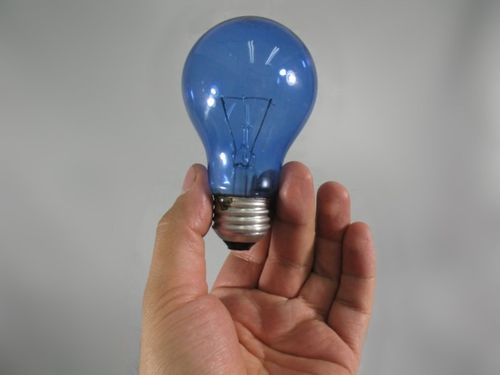
The durability of a device is determined not so much by the quality of the semiconductor - it is extremely difficult to destroy it - but by the operating time of the ballasts. And the latter does not like voltage drops or low voltage and can fail long before the specified period expires.
The main advantage of LED light sources is significant energy savings. You can get tangible and desired results using the products of the Svetovoy online store.
Energy-saving fluorescent lamps, which have already become familiar to many, are gradually becoming a thing of the past. It is being replaced by lighting equipment of a fundamentally new type, with different light and quality characteristics. Modern LED light sources have a whole range of advantages over their predecessors. This concerns light output, energy consumption, service life, environmental friendliness, fire and mechanical safety. The “disadvantages” that complicate their implementation include more high cost and conservatism of some part of the population.
To overcome doubts, it is enough to turn to LED lamp power correspondence table characteristics of previous generation light sources.
Comparison table of lamp characteristics: incandescent, halogen, energy-saving and LED lamps
|
Name |
Incandescent lamp |
Halogen lamp |
Fluorescent Lamp |
Light-emitting diode (LED) lamp |
|
Virtually no heat |
||||
|
Anti-vandalism |
Very fragile |
Virtually unbreakable |
||
|
Power, W) |
||||
|
Luminous flux (Lm) |
||||
|
Service life (hour) |
||||
|
Electricity fee per year (RUB) with 20 lamps in an apartment (at the rate of 4 rubles/kW, 5 hours a day) |
The correspondence table for the luminous efficiency of energy-saving (fluorescent) lamps and incandescent lamps corresponds to
LED and incandescent
It should be noted that the table figures are averages and may differ for specific products. Nevertheless, the conclusions are clear. Traditional, but obsolete, uneconomical light bulbs are losing out significantly. The given table of correspondence of LED lamp powers, even taking into account the inevitable error, convincingly proves the advantages of new generation systems. To this we must add a long service life, due to their design features and ensuring a quick and repeated payback. Analysis of tabular data and simple calculations show: the present and future belong to LEDs!
Content:Artificial lighting has long been firmly established in our daily life. All kinds of light sources are used everywhere - in houses, apartments, premises, offices, objects industrial production. Most consumers use conventional incandescent lamps with a power of 40, 60 and 100 watts. However, everyone knows that they have a very low coefficient useful action. Only half of the electricity is spent on lighting, the other half is spent on heating the light bulb itself. In this regard, energy-saving lamps are becoming increasingly popular.
The principle of operation of energy-saving lamps
This type of lamp, despite its high cost, is becoming increasingly widespread in many areas of people’s lives and activities. These light sources are compact in size and do not require a starter to start the lighting.
An important advantage of energy-saving light bulbs is their almost silent operation and very simple connection. All of them are equipped threaded bases, which are simply screwed into the desired lamp. The main advantages of these lamps include high reliability and efficiency, reaching 80%.
The principle of operation of energy-saving light bulbs is quite simple. Each lamp is filled with vapors of inert gases. First of all, it is argon, neon, and in some cases krypton. Some models use mercury vapor. When electricity enters the lamp, the cathode is heated and electrons are subsequently emitted. Under their influence, ionization occurs gas mixture. As a result, plasma is formed with ultraviolet light, which cannot be seen with the naked eye. Ultraviolet produces illumination of the phosphor covering the walls of the bulb. Ultimately, the phosphor produces ordinary visible light.
Characteristics
The most important indicator of each energy saving light bulbs its low power consumption is considered. Almost all the received power is converted into . There are tables to compare the performance of energy-saving lamps and conventional incandescent light bulbs. They clearly show the difference between lamps with the same light output. Thus, the difference is approximately 5 times. That is, with the same glow, a regular light bulb consumes 100 watts, and an energy-saving light bulb consumes 20 watts.
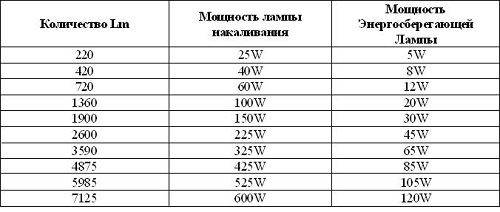
Table of power of energy-saving lamps and incandescent lamps.
The effective operation of a light bulb is determined by the luminous flux, which is an important distinguishing characteristic of each lighting device. This parameter is measured in lumens and the brightness of the glow directly depends on it.
The most important characteristic and feature of energy-saving lamps is. Modern models Available in threaded and pin versions. Some designs have sealed contact and may be non-standard. In any case, each base must be selected according to the cartridge.
Table of light parameters
One of the parameters characterizing a light bulb is color temperature. To measure it, there is a special Kelvin temperature scale. First of all, the degree of whiteness of the illumination emitted by the lamp is determined.
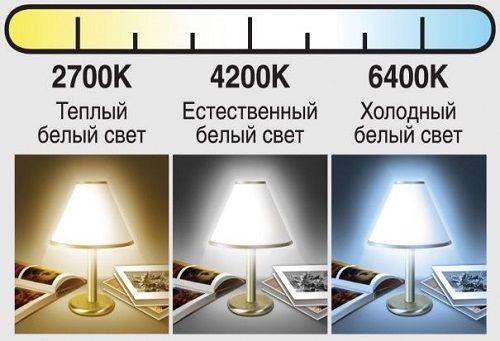
The main color temperatures include the following:
- Warm white, with an indicator below 3000 K.
- Neutral white ( natural light), is in the range of 3000-5000 K.
- Day white ( cold light) is over 5000 K.
In residential areas it is recommended to use soothing and relaxing warm shades. For office premises most the best option there will be light of cold tones. Natural light with a color temperature of 2800-3500 K is perceived best.
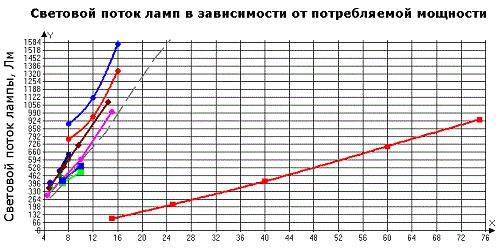
An important indicator is the luminous efficiency parameter, measured in lm/W. It determines the productivity of electricity and the amount of light produced by a particular light bulb. Great importance has the level of illumination of any surface, measured in lux (lx).
The transmission of natural tones of illuminated objects is determined using the color rendering index. For light bulbs, this indicator is related to spectral radiation. Absolutely correct transmission is indicated by the Ra index. A decrease in this indicator indicates a deterioration in color rendering properties.
Other indicators
The service life of energy-saving lamps is of no small importance. Normal operation largely depends on the number and speed of inclusions and other design parameters. These indicators make it possible to determine all the costs that determine the economic feasibility of purchasing such devices.
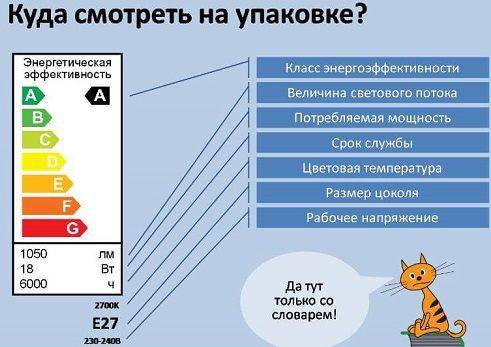
Product labeling makes it much easier right choice lighting device. There are special tables that are recommended to be used when purchasing energy-saving lamps.
Possible malfunctions and repairs
During the operation of energy-saving lamps, various malfunctions and breakdowns may occur:
- If the voltage is too high, the capacitor may swell and leak, causing the lamp to stop working. In this case, all semiconductors will need to be replaced.
- The increased voltage caused the capacitor to break through. The device glows at the locations of the filaments. In this case, the capacitor must be replaced.
- As a result of improper operation, the luminous flux begins to be distributed unevenly. The bulb is partially sealed, and the lamp itself cannot be repaired.
- If at least one filament burns out, the lamp will stop working. The capacitor will need to be checked, and at the site of the filament break, the diode is replaced with a resistor by desoldering.
- A faulty diode thyristor also needs to be replaced.
Energy-saving lamps can only be repaired after precise definition malfunctions and the availability of spare parts required for replacement. A complete transition to energy-saving lamps provides significant savings for the family budget.
To understand the relationship between LED and conventional incandescent lamps, it is necessary to compare their main parameters. But before finding out the correspondence for all technical specifications, let's look at the difference between each light source.
When performing simple comparisons between LED and incandescent lamps, you need to pay attention to their characteristics. In any light source, they are determined by the design and operating principle.
An incandescent lamp consists of a tungsten filament placed in a glass bulb. To provide optimal conditions work there is rarefied air inside the flask. The current passing through the spiral glows it, forming a bright glow. Due to the high resistance of tungsten, the power consumption of the lamp increases and, consequently, energy consumption.
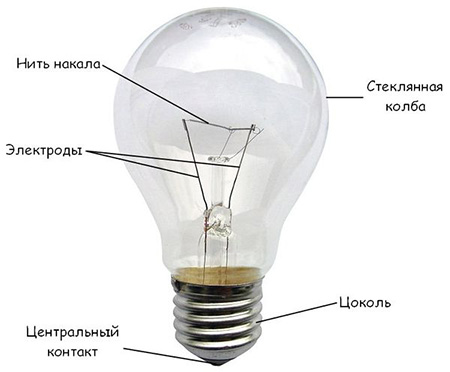
An LED lamp consists of LEDs connected in one circuit. Studying the design of an LED, it must be said that it is a crystal. By passing an electric current through itself, it emits photons, which appear as a bright glow. At the same time, the power consumption of LEDs is minimal.
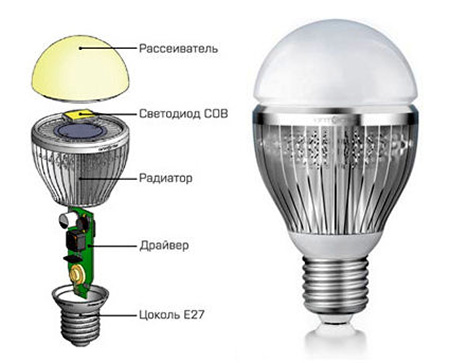
The efficiency of traditional filament light sources lies in their low cost. But in addition to the price of the product, you need to pay attention to power consumption and service life. If we compare the simplest correspondences of both light sources, it turns out that it is economically profitable to give preference to an LED lamp. If when arranging lighting there is a question of choosing a light source, then compare the difference in the simplest parameters:
- the power of LED lamps is almost ten times less than conventional incandescent models;
- an incandescent lamp illuminates the entire space around it, that is, the angle of illumination is 360 o. LEDs have directional light. Installed on one plane in an LED lamp, if necessary at different angles, they create a scattering angle of no more than 170 o;
- Lifetime LED light bulbs much longer. This is due to the fact that when glowing, the crystal heats up less, unlike a tungsten filament element. It is the intense heat that destroys the material that serves as the light source.
When making a purchase, compare the compliance of light bulbs with these simple indicators, it is clear that the equivalent of a conventional incandescent lamp wins - LED source Sveta. The cost of purchasing an LED lamp is offset by low power consumption and increased service life.
![]()
Comparison of light bulbs in all respects
So, we have examined, so to speak, the superficial parameters that people first pay attention to when comparing different models before purchasing them. Now is the time to delve deeper, finding out the compliance of the light bulbs with all technical characteristics.
Power and light output indicators
When determining the ratio of different light sources, it is first necessary to compare their power and light output. To determine power it is used unit of measurement watt (W). But it is only responsible for electricity consumption and does not affect the brightness in any way. To determine the degree of illumination of a space from light bulbs, you need to know their light output.
Incandescent light bulbs have a luminous efficiency of approximately 10 Lm/W. LED lamps emit a flux within 77 Lm/W, although the light output of some models can reach large values, for example, 90 Lm/W. Consequently, LEDs are 7-10 times more lumens than incandescent filaments. You need to know that different lighting devices of the same power may have different luminous efficiency. This is due to losses caused by the degree of transparency of the bulb, the use of a low-quality reflector and other factors.
To compare the light output ratio different lamps, there is a table. From it we can conclude that LED has almost five times less power with the same light output.
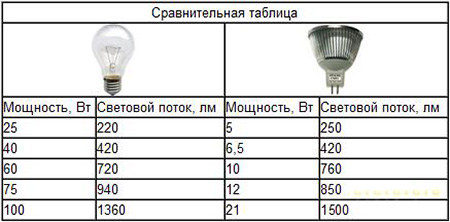
To independently design home lighting, you can use the following table comparing light sources by power:
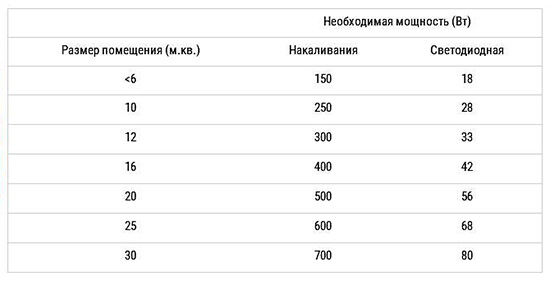
There are situations when it is not possible to select an LED light source required power. The way out of the situation would be to install several products that working together will create the required luminous flux.
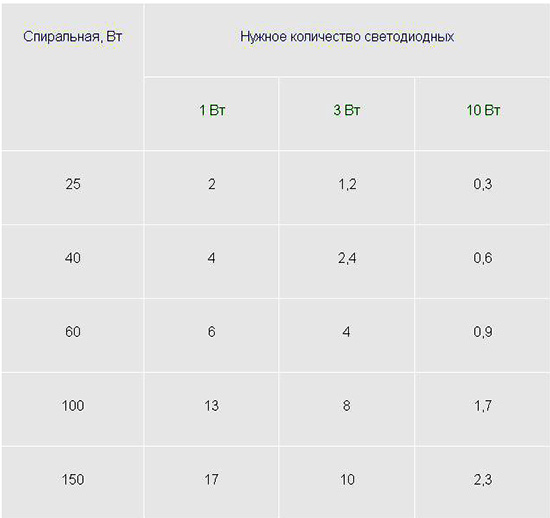
The table indicates what power equivalent to a spiral light source can be selected from several LED bulbs. In this case, the fractional number must be taken in the direction of increase.
Comparison by heat transfer
With the advent suspended ceilings and other finishing materials that react to high temperatures, an important indicator in the comparison was the heat transfer of lighting fixtures. The fact is that incandescent lamps can deform low-melting material, since their bulb heats up to 170 o C. wooden houses They are generally a fire hazard.
LED's maximum operating temperature does not exceed 50 o C, regardless of how many watts it has. This indicator allows it to be used with any finishing materials and in any room.
Lifetime
Spiral models are designed for 1 thousand hours of operation, although practice shows less results. LED lamps can work 50 times longer. From an economic point of view, this is beneficial to the consumer.
Efficiency
Comparing the efficiency of these light sources, it should be noted that the indicator of spiral models barely reaches 9%. For LED bulbs this figure reaches 90%. Consequently, the spiral converts ten times less light from electricity than an LED. Everything else goes into thermal energy to warm up the flask.
How to find an equivalent?
When arranging lighting and replacing outdated lighting fixtures with new, more economical ones, you need to find an equivalent for them:
- common outdoor device lighting with a power of 250 watts was equipped with a DRL lamp. Its equivalent will be an LED lamp with a large E40 base and thirty bright LEDs with a power of 30 watts;
- For room lighting The equivalent of spiral light sources are LED lamps with E27 or E14 socket.
Today, consumers have the opportunity to choose from a huge selection of new light sources to replace outdated lamps. You can always find a worthy replacement by choosing a more economical option.
In contact with




